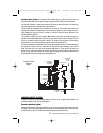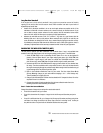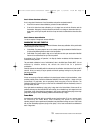
10
Edelbrock Performer Series Carburetor Owner’s Manual 9/01
To help you calibrate your carburetor, a CALIBRATION REFERENCE CHART has been designed for each
model of the Edelbrock Performer Series carburetor. These charts (pages 18—31) each consist of two
sections: A Calibration Table and a Rod/Jet Reference Chart.
After reading the Calibration procedures, the next step in calibrating your carburetor is to look at the
Calibration Table for your model carburetor. Determine if you would like to go richer or leaner in the
Cruise Mode and do the same for the Power Mode. Select the number that is closest to intersection of
your Cruise and Power Mode selections. This is your calibration reference number. Now refer to the
Rod/Jet Reference Chart that appears on the opposing page. Locate your calibration reference
number to determine the rod/jet combination for your application.
For example, you have a 1405 Edelbrock Performer Series carburetor. You have determined (by
reading the rest of the manual) you would like to go 1 stage lean in the Cruise Mode and 2 stages lean
in the Power Mode. The intersection of these two lines lies on the number 21. This is your calibration
reference number. Now look below the Calibration Table to the Rod/Jet Reference Chart. Find the
number 21 under the REF# column. The jets you should use are .098 and the rods are .070 x .052.
Located at the very bottom of each Calibration Reference Chart is a guide for changing your
Secondary Metering. This will be useful when calibrating the wide-open-throttle (WOT).
Before you attempt to establish a new calibration, be sure that the engine is in a sound state of tune.
All ignition items must be in proper working order, including reasonably fresh plugs of the correct heat
range. Timing should be properly set and the air filter element and fuel filter should be clean.
Proper fuel pressure should be verified and cracked or brittle vacuum lines should be
eliminated. Many so-called “carburetor calibration” problems have been traced to another part of the
engine system that was not functioning properly.
CAUTION: Be alert to carburetor flooding when fuel is first applied. Flooding can be caused by dirt,
small particles of hose cuttings, floats and inlet needles which have settled during shipping, or
by other conditions as discussed below. Each Edelbrock Performer Series carburetor is flow
tested in the factory for both air and liquid flow so flooding is rare. However, for safety sake
please observe this caution. When the fuel pump is turned on or when the engine is first started,
watch closely for signs of flooding. If flooding is apparent, tap the body of the carburetor lightly
with a rawhide mallet or the wooden handle of a small hammer. If flooding continues, pinch the
fuel line hose to shut off flow, run the engine to clear the carburetor, and let the fuel line flow
again. If flooding continues, pinch the fuel line hose to shut off flow, run the engine to clear the
carburetor, and let the fuel line flow again. If flooding still continues, stop the engine. Clean up
any raw gasoline and refer to the “Trouble Shooting” section of the Owner’s Manual.
Parts and Equipment —
Aside from ordinary hand tools, the following items are recommended.
• Edelbrock Performer Series Carburetor Jet Set - Contains selections of Main Jets,
Metering Rods, and Springs.
• Tachometer - If the vehicle is not equipped with a tach, the dwell meter style tach will
be adequate. If neither is available, you will be able to use the speedometer in place
of the tach for some of the procedures, but it will not be as convenient.
• Vacuum Gauge - Should be hooked up to read engine’s intake manifold vacuum.
Without a vacuum gauge, some of the calibration procedures will be more difficult.
1403-1413 Perf Series Carburetor Owner's Manual.qxd 3/31/2006 12:04 PM Page 10


















